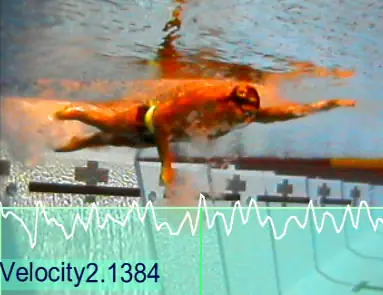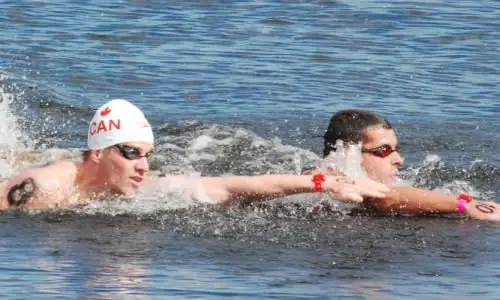In a SwiMetrics stroke analysis of the world's elite swimmers there were numerous subtle--but very important--differences between the swimming technique of elite and average swimmers in open water. The most significant difference was the relative drop in velocity (i.e., forward speed) during sighting. While SwiMetrics measures a relatively small decrease in velocity during sighting of elite athletes, the decrease in velocity of average swimmers is quite significant.
Assuming elite and average swimmers sight every 10--20 strokes, the number of sighting can range between 250--400 sightings in an 2.4-mile Ironman swim leg. With such a disparate difference in the velocity during these 250--400 sighting opportunities, the overall time differences also become significant.
When beginner triathletes and open water swimmers raise their head to sight, the most common tendencies that negatively affect their velocity include:
- A drop in the hips and legs
- A change in hand and forearm position
- A cross-over kick
- A pause in the kick
Conversely, when elite swimmers raise their head to sight, the swimming technique has the following characteristics:
- Minimal drop in the hips and legs
- Minimal change in their hand and forearm position
- Kicking of their feet up-and-down, perpendicular to the water surface
- A continued kick without pause
In the SwiMetrics photo below, the elite athlete's instantaneous velocity is shown as 2.1384 meters per second. This velocity is represented at the intersection of the vertical green line and the curved white line when his right arm is under his torso. Because the white line is representative of his speed at every moment of his stroke, you can see how his velocity has a significant decrease to the right of the green line--when he finishes his right arm stroke and begins his left hand entry.

When elite athletes sight in the open water their velocity does decrease. However, because they have a strong core and continue to kick efficiently, their hips and feet do not drop much and they maintain a relatively consistent velocity. Their bodies remain in the optimal streamlined position with a body position parallel to the water's surface and pointed toes kicking perpendicular to the water's surface.

Additionally, as their hand enters the water, they tend to press the water backwards--not down as many inexperienced swimmers do. By pressing the water downwards, a swimmer's forward velocity is negatively affected. On the other hand, as an elite athlete's hand enters the water, their fingertips begin to point downwards which enables them to quickly get into a high elbow position and press the water backwards. By pressing the water backwards, they quickly generate propulsion forwards.
Also, because their inertia and arm stroke tempo are higher than the average swimmer, the amount of time that their head is above the water is correspondingly less. By minimizing the amount of time they raise their head, the negative effects of sighting are also minimized.
In order to emulate the effective strokes of elite athletes, triathletes can do a number of drills in the pool. These drills should focus on maintaining a body position parallel to the surface of the water, pointing the fingertips downwards upon hand entry and a continuous kick during the sighting cycle.


